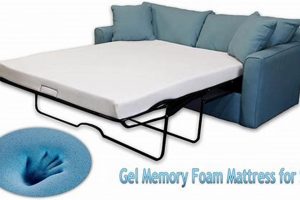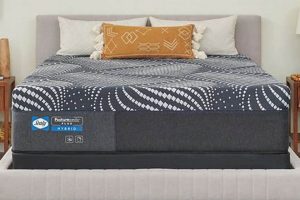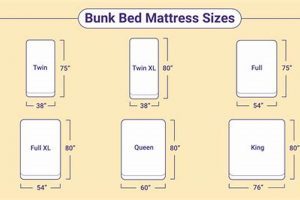Fecal stains left by these parasitic insects on bedding are a key indicator of infestation. These dark, often reddish-brown or black spots, resemble the tip of a felt-tip marker and may be slightly raised. Their presence on a sleeping surface is a strong sign of active bed bug activity.
Identifying these telltale marks early is crucial for prompt intervention. Early detection facilitates quicker and less extensive treatment, reducing costs and minimizing the potential for widespread infestation. Historically, recognizing these signs has been paramount in controlling these pests, as visual evidence remains a reliable method for confirming their presence.
Consequently, understanding how to identify these markings, differentiating them from other stains, and implementing effective removal and prevention strategies are essential topics for comprehensive pest management.
Identification and Management Strategies
The following guidelines offer practical advice for identifying and managing signs of bed bug activity on sleeping surfaces.
Tip 1: Thorough Inspection: Conduct a detailed examination of the entire mattress surface, paying close attention to seams, tufts, and edges. Use a flashlight to illuminate hard-to-see areas.
Tip 2: Differentiate from Other Stains: Distinguish bed bug fecal matter from other stains like mold or food residue. Bed bug droppings typically appear as small, dark spots that spread slightly when wiped with a damp cloth.
Tip 3: Inspect Surrounding Areas: Extend the inspection beyond the mattress to include the bed frame, headboard, and nearby furniture. These areas can also harbor the insects and their waste.
Tip 4: Use a Magnifying Glass: Employ a magnifying glass for closer inspection of suspicious spots. This will aid in differentiating them from dust or other debris.
Tip 5: Professional Confirmation: If uncertain, consult a pest control professional for definitive identification. Their expertise can confirm the presence of bed bugs and recommend appropriate treatment strategies.
Tip 6: Containment Measures: If evidence is found, encase the mattress in a bed bug-proof cover. This helps contain the infestation and prevents the insects from spreading to other areas.
Tip 7: Implement a Cleaning Regimen: Regularly vacuum the mattress and surrounding areas to remove any potential fecal matter or eggs. Dispose of vacuum bags in a sealed container outdoors.
Adherence to these guidelines can aid in early detection and effective management of bed bug infestations, minimizing their impact on living spaces.
The subsequent sections will delve into effective removal techniques and preventative measures for maintaining a pest-free environment.
1. Confirmation of Presence
Visual confirmation of bed bug excrement on a mattress provides definitive evidence of an active infestation. Its identification serves as a critical first step in implementing effective remediation strategies. The presence of these droppings should initiate a thorough inspection and a considered response to mitigate the problem.
- Pattern Analysis
The distribution and concentration of fecal stains offer insights into bed bug congregation areas. A clustered pattern near seams and folds suggests higher activity in those specific regions. Analyzing these patterns informs targeted treatment strategies, concentrating efforts where the evidence indicates the greatest concentration of pests.
- Differentiation from Other Materials
Accurate identification requires differentiating bed bug excrement from other substances like mold, dust, or spilled liquids. These stains often appear as small, dark spots that smear when moistened, unlike mold which may have a more textured appearance. Proper differentiation prevents misdiagnosis and inappropriate treatment measures.
- Source Identification
While the stains confirm the presence of bed bugs, they do not necessarily indicate the source of the infestation. Further investigation may be needed to determine how the pests entered the environment. Identifying the source is essential for preventing future infestations.
- Quantification and Progression Tracking
Documenting the extent of the droppings provides a baseline for evaluating the effectiveness of treatment. Monitoring the appearance of new stains or changes in existing ones can track the progression of the infestation. This longitudinal data informs adjustments to treatment protocols for optimized outcomes.
In summation, bed bug droppings on a mattress not only confirm the presence of these pests but also provide valuable data for understanding the scope and progression of the infestation. The data, combined with strategic treatment and continued monitoring, contributes to successful pest control.
2. Infestation Severity Indicator
The presence and extent of fecal stains on a mattress serve as a significant indicator of bed bug infestation severity. This visual evidence provides insight into the population size and duration of the infestation, guiding the selection and implementation of appropriate control measures.
- Density of Fecal Matter
The concentration of droppings correlates with the number of bed bugs present. A higher density suggests a larger, more established population. Heavily soiled areas indicate prolonged activity and may require more aggressive treatment approaches. Low density may reflect an early stage infestation or a smaller population, potentially manageable with less intensive interventions.
- Distribution Patterns
The spatial arrangement of fecal stains provides clues about bed bug harborage areas. Clusters along mattress seams, tufts, and folds point to preferred hiding spots. Widespread distribution suggests a more advanced infestation, where bed bugs have dispersed beyond their initial hiding places. Concentrated patterns allow for targeted treatment, while diffuse patterns necessitate a broader application of control measures.
- Age of Stains
While determining the exact age of individual stains is difficult, the overall appearance can provide some indication of the infestation’s duration. Older, dried stains suggest a longer-term presence, while fresh, moist stains indicate recent activity. The presence of both old and new stains points to an ongoing and potentially growing population.
- Correlation with Other Signs
Bed bug droppings should be considered in conjunction with other indicators, such as shed skins, live insects, and bites on occupants. A high density of fecal stains coupled with numerous other signs
suggests a severe infestation requiring immediate and comprehensive action. Conversely, a few droppings with no other signs may indicate a resolving issue or a very early stage.
Therefore, analyzing the fecal matter found on a mattress offers valuable insights into the extent and development of a bed bug problem. Accurate interpretation of this data facilitates informed decision-making in selecting and applying effective control strategies, ultimately leading to successful elimination of the infestation.
3. Visual identification
Visual identification plays a critical role in confirming the presence of bed bug infestations through the detection of their fecal matter on mattresses. Recognizing these signs allows for prompt action, mitigating potential health concerns and preventing the spread of the infestation.
- Color and Consistency Assessment
Bed bug droppings typically appear as small, dark spots, often reddish-brown or black, resembling the tip of a felt-tip pen. The consistency can vary from liquid to solid, depending on the age of the stain. This distinctive appearance enables differentiation from other common stains found on mattresses, such as food residue or mold.
- Pattern Recognition
The distribution pattern of these markings can indicate areas of high bed bug activity. They are frequently found clustered along mattress seams, tufts, and edges, which serve as common harborage sites. Recognizing these patterns facilitates targeted inspection and treatment efforts.
- Size and Shape Differentiation
Bed bug fecal stains are typically small, ranging from 1 to 3 millimeters in diameter, and may appear as either distinct spots or smears. The size and shape can help distinguish them from other debris or staining agents that may be present on the mattress surface.
- Contextual Analysis with Other Signs
Visual identification of droppings is most effective when combined with other indicators of bed bug presence, such as shed skins, live insects, or bite marks on occupants. A comprehensive assessment of these signs provides a more accurate diagnosis and informs the appropriate course of action.
The ability to visually identify bed bug droppings on a mattress is an essential skill for homeowners, pest control professionals, and hospitality staff. Early and accurate identification enables timely intervention, reducing the potential for extensive infestations and associated health and economic consequences.
4. Cleaning protocols
The presence of fecal stains on a mattress necessitates adherence to specific cleaning protocols to mitigate potential health risks and prevent further infestation. Standard cleaning methods are often insufficient to address the biological components present in these droppings, which can harbor allergens or pathogens. Cause and effect are directly linked; the droppings, a consequence of infestation, require specialized cleaning protocols to eliminate the potential adverse effects. The importance of appropriate cleaning is paramount, as incomplete or improper removal can leave behind residues that continue to attract the pests or trigger allergic reactions. For instance, simply wiping the surface with a damp cloth may spread the stain without effectively sanitizing the area. Bed bug-specific cleaning protocols involve using hot water, high heat drying, and potentially specialized enzymatic cleaners designed to break down the organic matter present in the droppings.
Continuing with further analysis, the practical application of these protocols extends beyond mere aesthetic improvement. The physical removal of fecal matter reduces the available food source for newly hatched nymphs and minimizes the spread of pheromones that attract more bed bugs. Real-life examples highlight this; hotels with proactive, documented bed bug cleaning protocols experience fewer re-infestations than those relying on superficial cleaning methods. Vacuuming the mattress using a HEPA filter, followed by steam cleaning at temperatures exceeding 130F, is one effective method. The implementation should also include the sanitization of surrounding areas, such as bed frames and carpets, to ensure comprehensive treatment. Regular inspection post-cleaning is also vital to check for residual traces or emerging signs of continued activity, requiring immediate application of protocol.
In conclusion, effective cleaning protocols are essential for addressing mattresses soiled with bed bug droppings. It reduces allergens and helps to manage and control bed bugs. Challenges involve the meticulous nature of the process and the potential for overlooking hidden infestations. However, understanding the biological nature of the droppings and implementing a thorough, multi-stage cleaning protocol represents a critical component of comprehensive bed bug management, contributing to a healthier and pest-free sleeping environment. This proactive approach addresses the existing problem and minimizes the risk of recurrence.
5. Health implications
Bed bug fecal matter on a mattress presents potential health implications, though typically indirect. The primary concern is the exacerbation of allergic reactions in sensitized individuals. While bed bugs are not known to transmit diseases directly through their droppings, the accumulation of fecal material can contribute to an unsanitary sleeping environment. The droppings contain proteins and other organic compounds that, over time, break down and become airborne, acting as allergens.
These allergens can trigger respiratory issues, skin irritation, and other allergic responses in susceptible individuals. For instance, individuals with pre-existing conditions like asthma or eczema may experience a worsening of their symptoms when exposed to high concentrations of bed bug allergens. Furthermore, the presence of fecal stains can be psychologically distressing, leading to anxiety and sleep disturbances, indirectly affecting physical health. The act of cleaning and disinfecting also has health implications. Harsh chemical products used in cleaning and bed bug eradication present inhalation and contact dangers. Therefore, a more natural cleaning alternative is beneficial.
In summary, though bed bug droppings themselves do not transmit disease, their presence on mattresses can have indirect health consequences, primarily related to allergic reactions and psychological distress. Effective management strategies, including thorough cleaning and allergen reduction, are necessary to minimize these risks and ensure a healthy sleeping environment. Long term exposure may affect more sensitive patients such as children or the elderly.
Frequently Asked Questions
The following questions address common concerns regarding bed bug fecal stains on mattresses, providing factual information to aid in identification and management.
Question 1: What do bed bug droppings look like on a mattress?
Fecal stains typically appear as small, dark spots, often reddish-brown or black in color. They may resemble the tip of a felt-tip pen and tend to smear when wiped with a damp cloth.
Question 2: Where are bed bug droppings most commonly found on a mattress?
These stains are frequently located along mattress seams, tufts, and edges, as these areas offer ideal hiding places for the insects.
Question 3: Can bed bug droppings cause health problems?
While bed bug droppings are not known to transmit diseases, they can trigger allergic reactions in sensitized individuals, potentially exacerbating respiratory issues or skin irritation.
Question 4: How can bed bug droppings be distinguished from other types of stains on a mattress?
Bed bug stains tend to be small, dark spots that smear when moistened, unlike mold, which often has a textured appearance, or food stains, which may vary in color and consistency.
Question 5: What cleaning methods are effective for removing bed bug droppings from a mattress?
Effective cleaning methods include vacuuming with a HEPA filter, steam cleaning at high temperatures, and the use of enzymatic cleaners designed to break down organic matter. Standard cleaning methods may not fully eliminate residues.
Question 6: Does the presence of bed bug droppings always indicate an active infestation?
Yes, the presence of fecal stains strongly suggests an active bed bug infestation. However, the extent of the infestation may vary, requiring a thorough inspection and appropriate control measures.
The information provided herein offers insights into the characteristics, implications, and management of bed bug droppings on mattresses. It is important to implement comprehensive strategies for successful pest control.
The subsequent section will address preventative measures and strategies to maintain a bed bug-free environment.
Concluding Considerations
The preceding discussion has illuminated the critical significance of identifying and addressing bed bug droppings on mattresses. These telltale marks serve as primary indicators of infestation, influencing the scope and urgency of necessary interventions. The ability to differentiate these stains from other blemishes, coupled with a clear understanding of their potential health implications, is paramount for effective pest management.
The consistent and thorough monitoring of mattresses for evidence of bed bug activity, coupled with the prompt implementation of appropriate cleaning and control measures, remains essential. A proactive approach minimizes the risk of widespread infestations and preserves a healthy, pest-free environment. Continued vigilance and adherence to recommended practices are crucial in mitigating the challenges posed by these persistent pests.



![Best Queen Adjustable Bed & Mattress [Guide & Reviews] Organic & Natural Mattress Buyer’s Guide: Non-Toxic Sleep Solutions Best Queen Adjustable Bed & Mattress [Guide & Reviews] | Organic & Natural Mattress Buyer’s Guide: Non-Toxic Sleep Solutions](https://mattressworldpa.com/wp-content/uploads/2025/07/th-7128-300x200.jpg)



